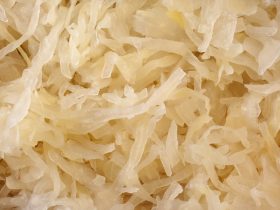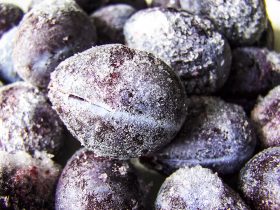The carrot’s paler cousin, parsnips are subterranean-growing vegetables originally cultivated by the Roman empire1. With a taste even sweeter than carrots, parsnips soon gained popularity across much of the modern world.
Because of the parsnip’s high sugar content, it is often the prime target of many insects, and must either be consumed immediately or stored properly.
Yes, parsnips can be frozen, though the process of freezing this root vegetable is somewhat more complicated than throwing it in the freezer. According to a study conducted by the U.S. Department of Agriculture, the ideal preservation temperature for parsnips is 30.4°F, so long as humidity is kept at acceptable levels2.
How Long do Parsnips Last in the Freezer?
As the freezer is the ultimate solution in terms of long-term storage for your organic produce, it is the most advisable choice. If you need to preserve your parsnips for up to nine months, freezing them is the only possible route.
Keep in mind that the exact length of time the freezer can preserve the parsnips is variable, as many factors can compromise the vegetable. A more accurate estimate would be six to nine months.
How to Prepare Parsnips for Freezing

To begin preparing your parsnips for a long stay in the freezer, you will need a paring knife (and a vegetable peeler if available), a stove, a bowl of ice water, a pot, as well as a resealable plastic bag or freezer-safe container.
Begin by first scrubbing the parsnips beneath running tap water, removing any excess root-tendrils and dirt. As you are doing this, fill a pot with water and bring to a boil on the stove.
Once properly washed, using a knife or vegetable peeler, remove the thin layer of skin on the surface of the parsnips. Discard the peels, as they contain a toxin that may be irritating to human skin.
Using your paring knife, cut off both the tip and the stem-end of the parsnip. Cut into small enough pieces that they may fit into your desired freezing container. Before proceeding, ensure that your bowl of ice water is ready at hand.
How to Blanch Parsnips
Rinse the cut pieces of vegetable one final time before plunging into the pot of boiling water for three minutes. Remove quickly and immediately submerge beneath the ice water.
This process is referred to as blanching, and interrupts the enzymatic action of fresh produce as well as kills microorganisms, extending the parsnip’s shelf-life.
How to Freeze Parsnips
After blanching, place the now cooled parsnip pieces into your container, leaving as little air within it as possible. Though optional, placing a single sheaf of tissue paper along the top will help extend the shelf-life of your parsnips somewhat.
Place in the freezer for up to nine months, though this will be shortened if they are removed from the freezer temporarily.
How to Freeze Cooked Parsnips
In order to freeze already cooked parsnip, first allow them to cool on a lined baking tray after cooking. Place the baking tray uncovered in the freezer for two hours before removing. After removing, simply place the frozen parsnips in a container and return to the freezer.
This step is done to prevent the parsnips from freezing into a single mass, as well as to ensure each piece is cooled thoroughly.
How to Thaw Parsnips
In the event that you are retrieving your parsnips from the freezer to use in a stew or soup, simply taking the needed amount from the container and placing in your dish as it is cooking will suffice.
On the other hand, if choosing to thaw your parsnips for other purposes such as deep-frying or baking, it is best to take the parsnips from their container and to place them in a bowl. Leave the vegetables in the fridge overnight so they may defrost fully.
How Long Do Cooked Parsnips Last When Stored?
If already cooked, parsnips will only last up to six months when stored in the freezer.
Keep in mind that, like all organic produce, freezing will affect the parsnips’ texture and flavor. It is best to freeze them before they are cooked instead, especially if you are choosing to glaze them.
How Long do Parsnips Last on the Counter?
If choosing to forgo the process of refrigerating or freezing your parsnips, it is possible to leave this vegetable on your counter-top.
In order to do this, ensure that the vegetable is placed in a dark and cool area free of moisture. Direct sunlight will also affect the vegetable, so it is best to store the parsnips away from uncovered windows.
If left intact, the parsnip will remain edible for up to five days, so long as the conditions are ideal.
Can You Refrigerate Parsnips?
Far preferable to simply leaving the parsnips on your counter-top, electing to refrigerate your parsnips will extend their shelf-life significantly.
Do not expose your parsnips to water if choosing to store them. Instead, simply wipe the surface off with a dry paper towel before placing it in the crisper drawer of your refrigerator.
If temperature and humidity are within the correct parameters, your parsnips will last for up to an entire month in the fridge.
How to Know if Parsnips have Gone Bad
Much like carrots, signs of spoilage in parsnips are often first apparent by touching them.
If the surface is dry and spongy, and the flesh easily gives way to a gentle squeeze, it is likely that the parsnip is not safe for consumption, and should be disposed of.
Additionally, the appearance of off-color patches as well as sludge may indicate bacterial colonization of the vegetable. Throw the vegetable out if you encounter this.
Note that the process of freezing and thawing may discolor the parsnips somewhat. This is entirely normal, and not a sign of them going bad, so long as no unusual odors or other signs of spoilage are present.
References:
1. Venema, Christine (2015). “Parsnips: A vegetable from antiquity”. Michigan State University
2. Hardenburg A.E. Watada and C.Y. Wang. (1986). “The Commercial Storage of Fruits, Vegetables, and Florist and Nursery Stocks.” USDA-ARS Agriculture Handbook





Hi, I'm Dom
Dom Eats was started to help other people fall in love with food. While cooking can feel intimidating, it doesn't have to be.